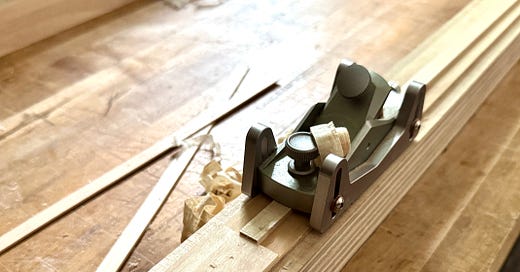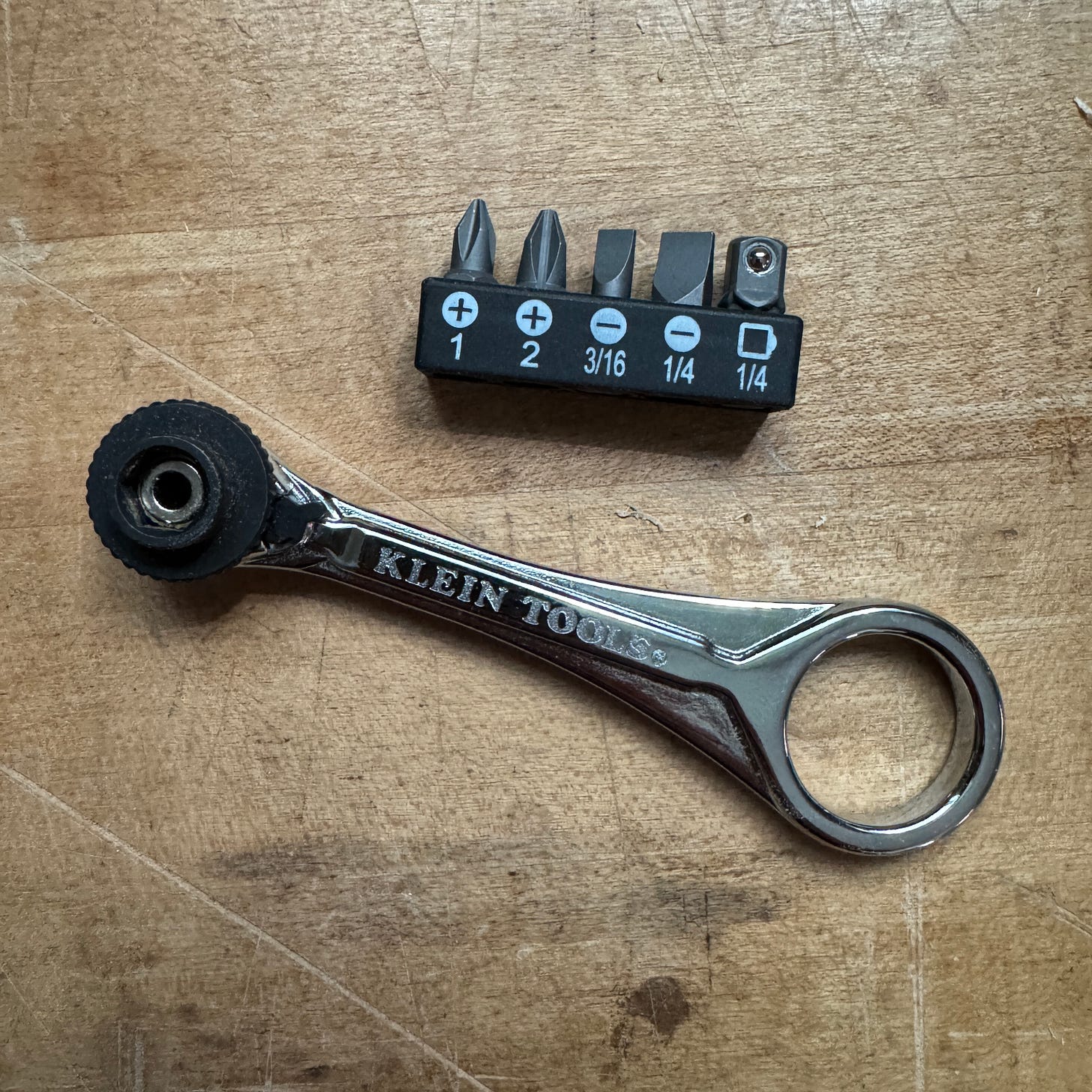2 Tools that I Love and 1 that's Left Me Sad
The perfect plane for kumiko, an awesome ratchet, and a clamp that breaks my heart
I’ve coordinated a ton of tool reviews, and even conducted quite a few. I hate them with a passion now. I hope to never participate in another one, but I am happy to share my personal experience with tools that I bought with my own money, and have found, through a good deal of use, to be great. I also am happy to tell you about tools that I bought and grew to loathe, or just find unhelpful. This week, there are three to tell you about: a small plane, an even smaller ratchet, and some clamps that don’t deserve claps.
Loving: Bridge City HP-8A low angle block plane
One of the more difficult challenges of kumiko is making the thin strips used for the lattice and the infill patterns. Ideally, they are uniform in thickness from one to the next, and along the length of each one individually. The strips also should have a clean, “presentable” surface. The ideal tool for the job is a well-tuned drum sander, but unless you already own one or intend to make a lot of kumiko and sell it, don’t bother with the drum sander. Instead, rip strips with your tablesaw or bandsaw, and then plane them to final thickness.
A sharp hand plane leaves a beautiful surface, so that’s one problem solved. The other problem, ensuring uniform thickness, is more difficult, because there is no way to guarantee that all of the strips will be the same thickness, at least not in an efficient manner. The solution is a specialized block plane like the Bridge City HP-8A, which has adjustable skates on both sides of its body. The skates allow you to suspend the plane body, and thus the blade, above the work surface. As you plane the strip, the skates eventually come into contact with your bench top (or whatever it is you are planing on top of), and the blade stops cutting. That ensures that every strip in the same thickness, and that the thickness is uniform along the entire length of the strip.
I absolutely love my HP-8A, and I recently bought a second one. (Keep an eye on Bridge City’s website. Sales occur often. I paid $49 for the one I just bought.) It’s a well-made plane. The body, skates, etc. are aluminum, and I like the overall weight. Blade adjustments are easy and accurate. The blade also arrives sharp, and I mean actually sharp. Perfectly thin and fluffy shavings are possible right from the box.
Setting the skates is not hard, but it doesn’t take practice. I have found that it’s best to retract the blade and rest the plane’s sole on a setup block or piece of wood that’s slightly thicker than the final thickness you want (or put a piece or two of blue tape on something that’s the exact thickness). Let the skates drop to the surface and then tighten the locking bolts. Make test cuts with the plane, advancing the depth of cut slowly until you’re hitting the correct final thickness.
Because I use mine so often, I’ve made little jigs that both hold the strips in place against a stop, and provide a surface on which to plane.
Loving: Klein Tools 65200 mini-ratchet
Cordless drills, nice screwdrivers, and the like are awesome, but sometimes space is tight and those tools are just tool big. That’s the case for me when I need to attach/remove a tabletop from a table with a drawer. The drawer runners just get in the way. The perfect tool for that situation is a ratcheting bit driver, and the best one I’ve used is the Klein Tools 65200. It’s tiny, and fits into the tightest spaces. It’s also very well made, like everything I own from Klein Tools. There is no slop in the ratchet mechanism. It holds bits securely but not so tightly that they are hard to get out. It not only works with standard hex shank bits, but also can drive 1/4 and 5/16 in. nuts. The included 1/4 in. socket adapters lets you pop any 1/4 in. socket onto it for a wider range of nut sizes. It’s an awesome tool.
Not loving, but not hating: Bessey Uniklamps
When I worked at Fine Woodworking, there were several Bessy Uniklamps in the shop, and I used them all the time. They are parallel jaw clamps, but lightweight, and perfect for glueing up drawers and other jobs where the strength of a full-size parallel jaw clamp isn’t needed. I ended up buying four for myself, and I use them all the time, but they have a major flaw that drives me crazy.
The parallel jaws are plastic, and not as robust as those on larger clamps. Pressure is applied by a round swiveling clamp head inside the plastic jaw. That round clamp head has a socket on the back side and a round “ball” on the end of the screw fits into it. (Larger parallel jaw clamps have a similar design, but it’s far more robust).
When new, that ball-and-socket joint is permanent. Sadly, it doesn’t stay that way. That joint has separated on all four Uniklamps that I own, and that means that before I use them, I’ve got to get a finger or bit of wood down into the plastic jaw (very tight quarters), and align the swivel head with the screw. Otherwise, the clamps just don’t work well.
It’s frustrating, because I actually love the Uniklamp. They really are perfect for a great deal of what I do, but it’s a fight every time I use them. I often want to chuck them against the wall. I don’t, because I’m an emotionally mature adult, but I so want to.
Something of a side note: the round clamping head and screw used for the Uniklamp appears to the same ones used in their small F-style clamps. Guess what. I’ve had several of those break on me, too. And I promise you, I do not abuse my tools. Ever.
Thanks for reading, and for subscribing. If you enjoy what I share, please consider a paid subscription. Also, feel free to share your thoughts or ask a question in the comments.







I also love the uniklamps. I had some problems with a few bessey clamps over the years and their customer service replaced them with no questions asked. Do the uniklamps have a lifetime warranty like the big boy parallel clamps? It was a relatively painless process.
As you know, some tools are made to sell, while others are made to use.